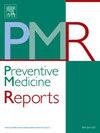Effectiveness and feasibility of family and peer challenge intervention with wearable technology on physical activity among middle schoolers in Utah: A pilot trial
IF 2.4
3区 医学
Q2 PUBLIC, ENVIRONMENTAL & OCCUPATIONAL HEALTH
引用次数: 0
Abstract
Objective
To examine the preliminary effectiveness and feasibility of physical activity (PA) intervention in middle schoolers.
Methods
This 6-week, multi-component PA intervention was conducted in Salt Lake City, Utah, between November 2021 and January 2022. The intervention included tracking daily PA using a wearable activity monitor, education on PA and health, weekly motivational videos, and group challenges within family or peer groups. Three classes from one public middle school (N = 75; 51 % girls, aged 12–13 years) were randomly allocated into the intervention (i.e., family or peer challenges) or control groups. Changes in daily activity time between pre- and post-intervention were assessed using ActiGraph accelerometers. The feasibility of the intervention was evaluated through measures of adherence, retention, and acceptability.
Results
After the intervention, 51 (girls: 51 %; age: 13.0 ± 0.7) of all participants completed the entire study protocol. Linear mixed models showed no statistically significant differences between interventions and control in daily sedentary behavior and PA times. Adherence to the intervention was moderately high (> 60 %), with a retention of 68 %. We also observed high satisfaction with wearable technology (≥ 78 %) in middle school students. However, only 39 % of participants frequently used the mobile app for their group challenge.
Conclusions
Wearable technology in PA intervention may be of interest to young adolescents but not effectively change youth PA behavior during a 6-week intervention. Further research with larger samples, longer intervention durations, and refined engagement strategies is required to more accurately evaluate the impact and feasibility of this intervention.
可穿戴技术对犹他州中学生体育活动的家庭和同伴挑战干预的有效性和可行性:一项试点试验
目的探讨体育活动(PA)干预在中学生中的初步有效性和可行性。方法这项为期6周的多组分PA干预于2021年11月至2022年1月在犹他州盐湖城进行。干预措施包括使用可穿戴活动监测器跟踪每天的PA, PA和健康教育,每周激励视频,以及家庭或同伴群体中的小组挑战。一所公立中学的三个班级(N = 75;51%的女孩(12-13岁)被随机分配到干预组(即家庭或同伴挑战组)或对照组。使用ActiGraph加速计评估干预前后每日活动时间的变化。通过依从性、保留性和可接受性来评估干预措施的可行性。结果干预后,51例(女孩:51%;年龄:13.0±0.7)完成整个研究方案。线性混合模型显示,干预组和对照组在日常久坐行为和PA时间上没有统计学上的显著差异。干预的依从性中等高(>;60%),保留率为68%。我们还观察到中学生对可穿戴技术的满意度很高(≥78%)。然而,只有39%的参与者经常在小组挑战中使用手机应用程序。结论在为期6周的干预中,可穿戴技术可能对青少年的PA干预感兴趣,但不能有效改变青少年的PA行为。为了更准确地评估这种干预的影响和可行性,需要进一步研究更大的样本、更长的干预持续时间和更精细的参与策略。
本文章由计算机程序翻译,如有差异,请以英文原文为准。
求助全文
约1分钟内获得全文
求助全文
来源期刊

Preventive Medicine Reports
Medicine-Public Health, Environmental and Occupational Health
CiteScore
3.90
自引率
0.00%
发文量
353
 求助内容:
求助内容: 应助结果提醒方式:
应助结果提醒方式:


